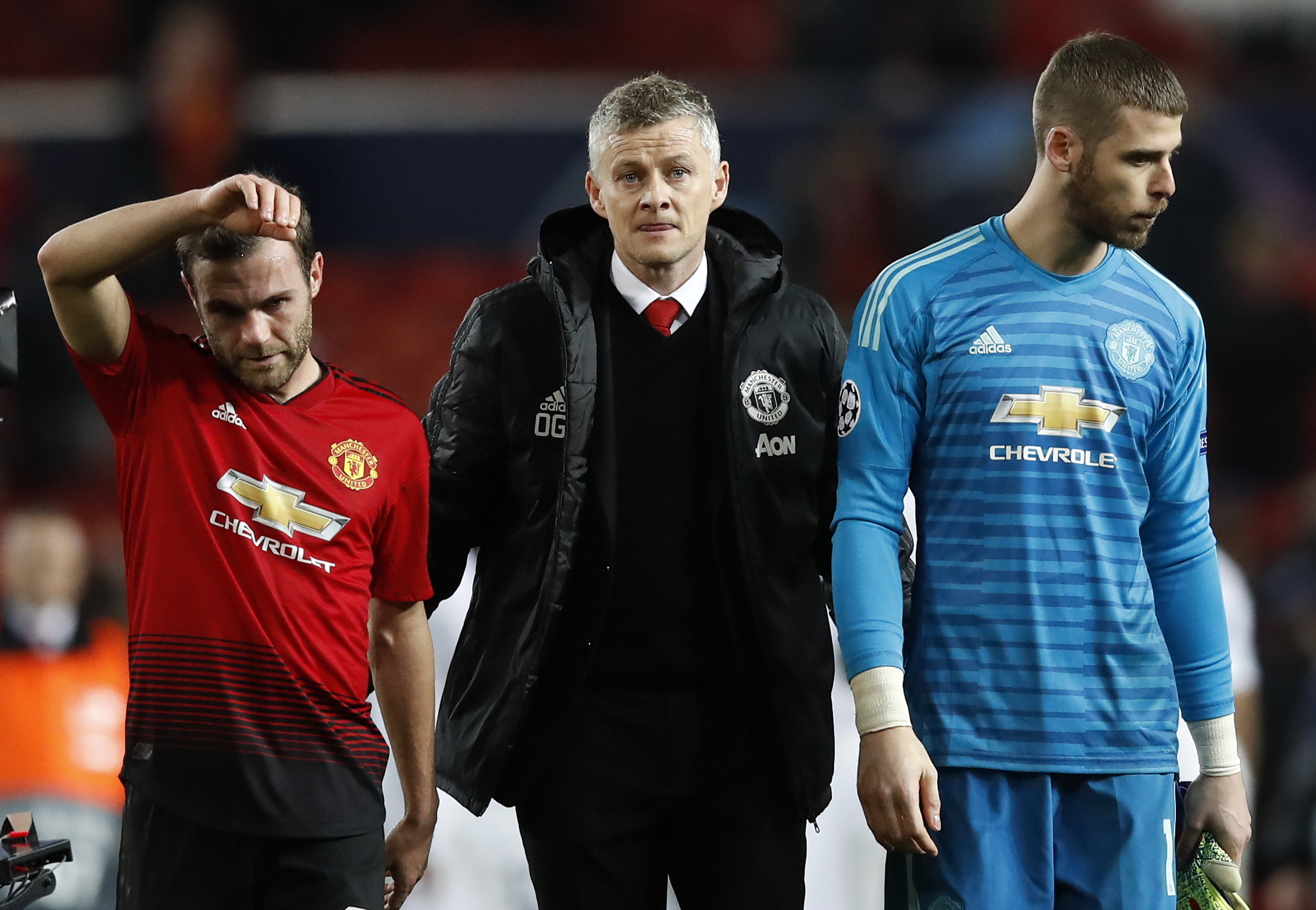It’s been quite the turnaround for Manchester United since Ole Gunnar Solskjær replaced José Mourinho in December. It seemed impossible to imagine at the tail end of last year that the feeling around Old Trafford could change so quickly. So joyless were Mourinho’s final months, that felt like this was all United were. Enter Solskjær. He’s won eleven out of thirteen games, making everyone reminisce over the memories of swashbuckling sides managed by Sir Alex Ferguson. As of writing this, the betting markets have the Norwegian as the odds on favourite to become the next United manager. Granted, the defeat to a much better Paris Saint-Germain has taken the shine off things, making now a good time to look at how things are actually going, and whether Solskjær might be capable of continuing this good form in the long term.
How Has Solskjær Changed United’s Approach?
Sometimes the pub narratives aren’t wrong. United are attacking a lot more under the new boss. Under Mourinho this season, the side were generating 1.29 expected goals per 90, a figure that has risen to 1.64 since Solskjær’s arrival. Not only are they taking about two extra shots per game, but they are taking better shots, with each having an estimated 11% chance of going in, compared to 9% under Mourinho. These don’t sound like huge differences, but the edges add up significantly. 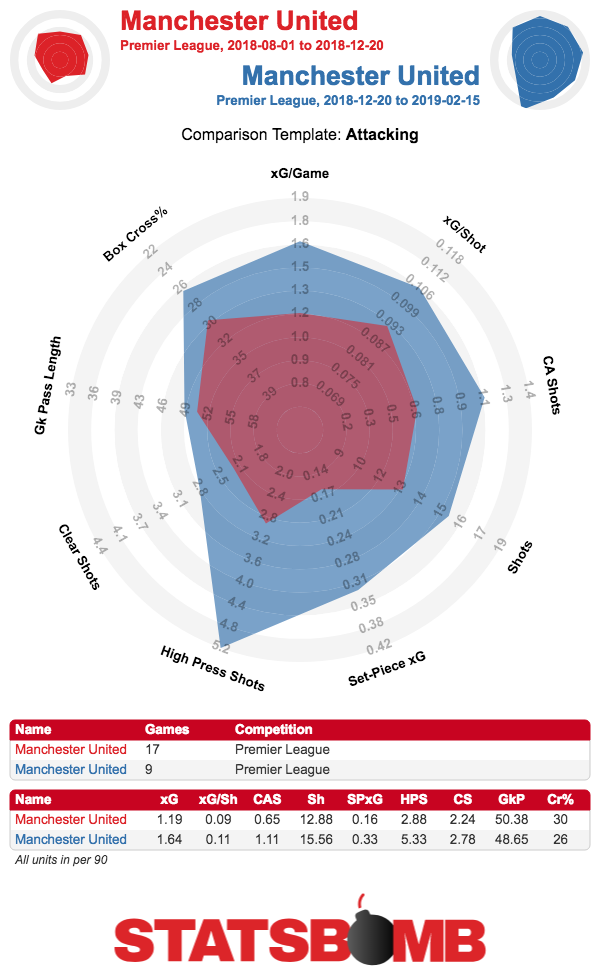 The most striking thing from the attacking team radars, other than an across the board improvement, is that United are taking nearly twice as many high press shots (“shots from possessions that were won within 5 seconds of a defensive action”) and counter attacking shots (“within 15 seconds of a possession that originates in the opposition’s own half”) as before. That mostly captures what everyone can see with their own eyes: Solskjær’s United are a higher pressing, faster breaking team than during Mourinho’s tenure. The way United are doing this isn’t all that tactically complex. Solskjær has stuck to a narrow 4-3-3 system, with a preferred attacking trio of Marcus Rashford, Jesse Lingard and Anthony Martial. While there have been certain situations where Lingard’s pressing has been favoured upfront, it’s generally been Rashford leading the line as the striker. And it’s fair to say that’s worked out pretty well so far.
The most striking thing from the attacking team radars, other than an across the board improvement, is that United are taking nearly twice as many high press shots (“shots from possessions that were won within 5 seconds of a defensive action”) and counter attacking shots (“within 15 seconds of a possession that originates in the opposition’s own half”) as before. That mostly captures what everyone can see with their own eyes: Solskjær’s United are a higher pressing, faster breaking team than during Mourinho’s tenure. The way United are doing this isn’t all that tactically complex. Solskjær has stuck to a narrow 4-3-3 system, with a preferred attacking trio of Marcus Rashford, Jesse Lingard and Anthony Martial. While there have been certain situations where Lingard’s pressing has been favoured upfront, it’s generally been Rashford leading the line as the striker. And it’s fair to say that’s worked out pretty well so far. 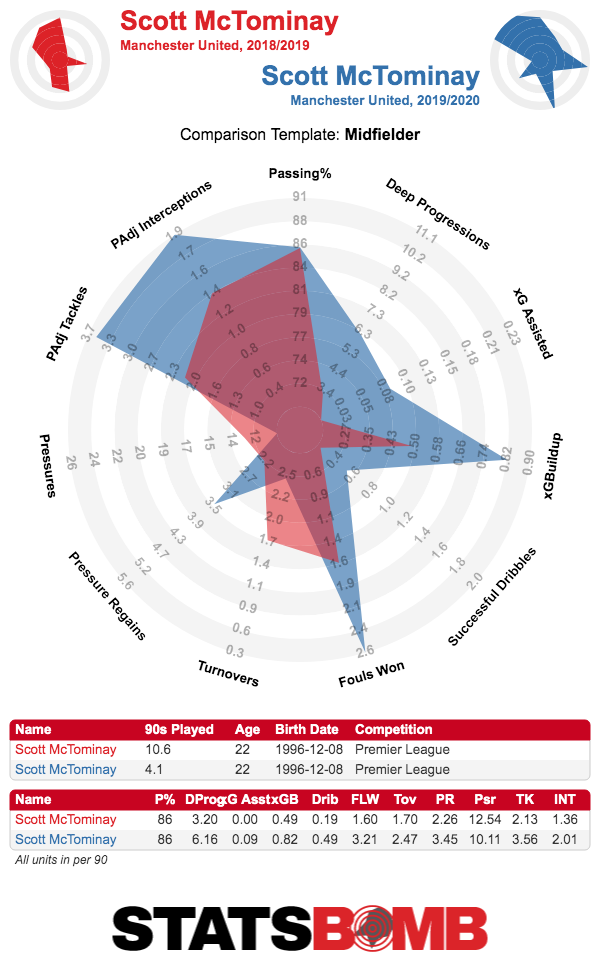 This is the first time in Rashford’s still very young career that his obvious talent has been met with a high level of shot production. The cynic would say that such a dramatic improvement is bound to be a blip, and that could well prove to be the case. But, there’s certainly an optimistic case for his form. This is the first time in the England international’s senior career that he’s played in a United team that wasn’t frustratingly conservative, and a relatively rare period of him being free of an “out and out” striker such as Romelu Lukaku or Zlatan Ibrahimović. His shot volume is certainly something to watch out for over the rest of the season. Fellow attackers Martial and Lingard have also been in good form, though the improvement has been more modest than Rashford’s.
This is the first time in Rashford’s still very young career that his obvious talent has been met with a high level of shot production. The cynic would say that such a dramatic improvement is bound to be a blip, and that could well prove to be the case. But, there’s certainly an optimistic case for his form. This is the first time in the England international’s senior career that he’s played in a United team that wasn’t frustratingly conservative, and a relatively rare period of him being free of an “out and out” striker such as Romelu Lukaku or Zlatan Ibrahimović. His shot volume is certainly something to watch out for over the rest of the season. Fellow attackers Martial and Lingard have also been in good form, though the improvement has been more modest than Rashford’s. 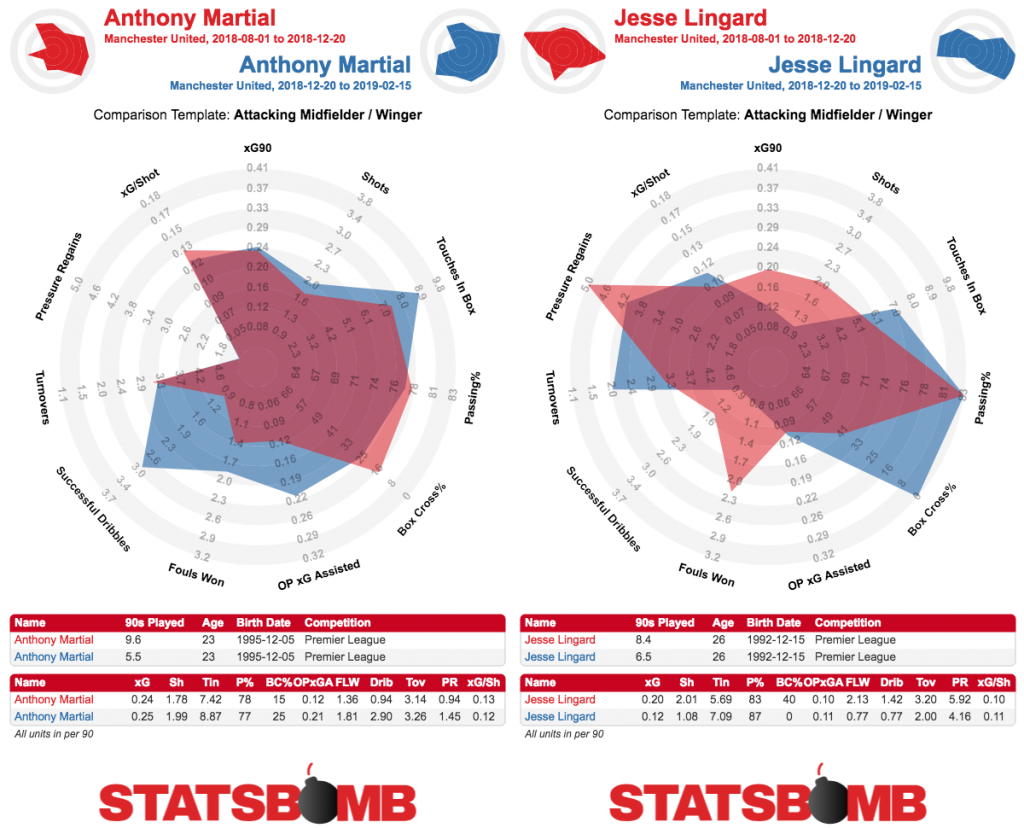 The most discussed player, though, is always Paul Pogba. The Frenchman’s time under Mourinho received a lot of criticism and its fair share of defenders. For the first two years of his United career he played largely as a sitting midfielder in a broad 4-2-3-1 shape, with Mourinho seeming to envision him having the same impact Cesc Fàbregas had as a deep-lying playmaker in the manager’s Chelsea side. This involved having to curb his natural instincts to move into the final third and join the attack, and while France managed to successfully do this in the World Cup, Pogba had N’Golo Kanté as a midfield partner to cover him. At United, he initially had Ander Herrera, himself more of a natural box-to-box player anyway, and then Nemanja Matić, ideal for the role in his prime but seemingly no longer able to cover the ground required. Thus, the double pivot had a hard time controlling the game, something for which Pogba received a lot of criticism. Mourinho’s fix for this was a three man midfield, which in theory should have got the most out of Pogba, but his consistent off-field feuds left the Frenchman often either in a restrained and unnatural role or simply not on the pitch.
The most discussed player, though, is always Paul Pogba. The Frenchman’s time under Mourinho received a lot of criticism and its fair share of defenders. For the first two years of his United career he played largely as a sitting midfielder in a broad 4-2-3-1 shape, with Mourinho seeming to envision him having the same impact Cesc Fàbregas had as a deep-lying playmaker in the manager’s Chelsea side. This involved having to curb his natural instincts to move into the final third and join the attack, and while France managed to successfully do this in the World Cup, Pogba had N’Golo Kanté as a midfield partner to cover him. At United, he initially had Ander Herrera, himself more of a natural box-to-box player anyway, and then Nemanja Matić, ideal for the role in his prime but seemingly no longer able to cover the ground required. Thus, the double pivot had a hard time controlling the game, something for which Pogba received a lot of criticism. Mourinho’s fix for this was a three man midfield, which in theory should have got the most out of Pogba, but his consistent off-field feuds left the Frenchman often either in a restrained and unnatural role or simply not on the pitch. 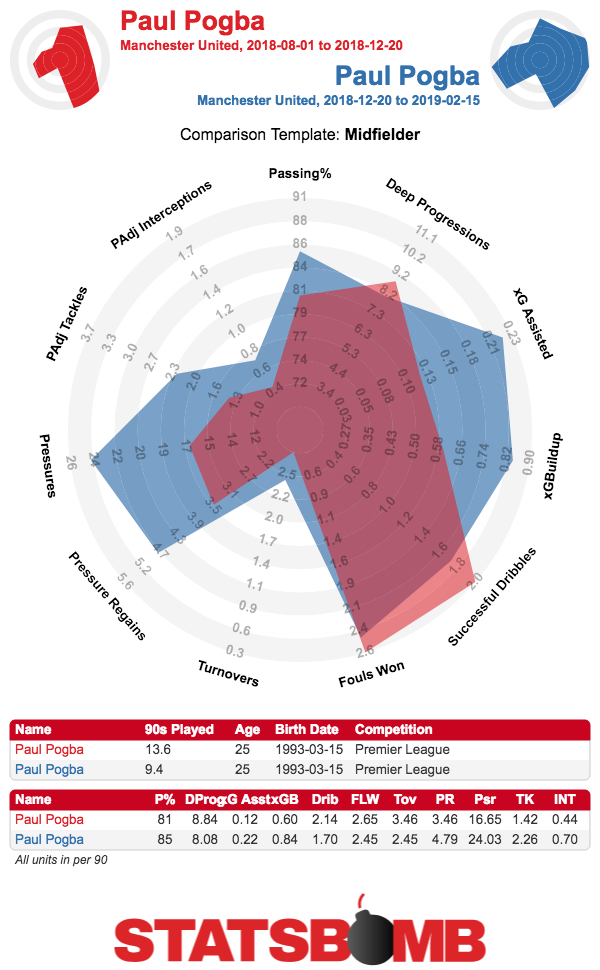 Surely the most straightforward decision Solskjær made was to let Pogba play his preferred game. As the most advanced player in a midfield three, Pogba has been encouraged to arrive in the box and join in with the attack where possible. He’s getting more touches in the box and more shots since the Norwegian took over. Surprisingly, his defensive workload has also increased, though this may also reflect on the more front foot approach under Solskjær. His deep progressions and dribbles have fallen a touch, perhaps illustrating that he is no longer being asked to dictate the game from deep. There are some out there who consider this a downgrade, with StatsBomb contributor Paul Riley calling his new role a “criminal waste of talent and game control”. There is also a question of whether the two deeper midfielders, Herrera and Matić, offer enough on the ball to help dictate things, with PSG showing that United have a hard time generating chances when Pogba is nullified. What it’s hard to deny, though, is Pogba’s effectiveness when breaking into the final third. He remains capable of sublime moments of individual quality while also combining with the other attackers much more fluently. He’s good at football.
Surely the most straightforward decision Solskjær made was to let Pogba play his preferred game. As the most advanced player in a midfield three, Pogba has been encouraged to arrive in the box and join in with the attack where possible. He’s getting more touches in the box and more shots since the Norwegian took over. Surprisingly, his defensive workload has also increased, though this may also reflect on the more front foot approach under Solskjær. His deep progressions and dribbles have fallen a touch, perhaps illustrating that he is no longer being asked to dictate the game from deep. There are some out there who consider this a downgrade, with StatsBomb contributor Paul Riley calling his new role a “criminal waste of talent and game control”. There is also a question of whether the two deeper midfielders, Herrera and Matić, offer enough on the ball to help dictate things, with PSG showing that United have a hard time generating chances when Pogba is nullified. What it’s hard to deny, though, is Pogba’s effectiveness when breaking into the final third. He remains capable of sublime moments of individual quality while also combining with the other attackers much more fluently. He’s good at football.
Can United Keep This Up?
One concern concern when watching Solskjær’s side is in how willing they are to push players forward. The commitment to attacking football without a clear, deliberate structure has often made United appear somewhat easy to hit on the counter. Of course, they have only conceded 5 non-penalty goals in the league. To understand how, we just need to take a look David de Gea, once again proving to be the team’s defensive cheat code. 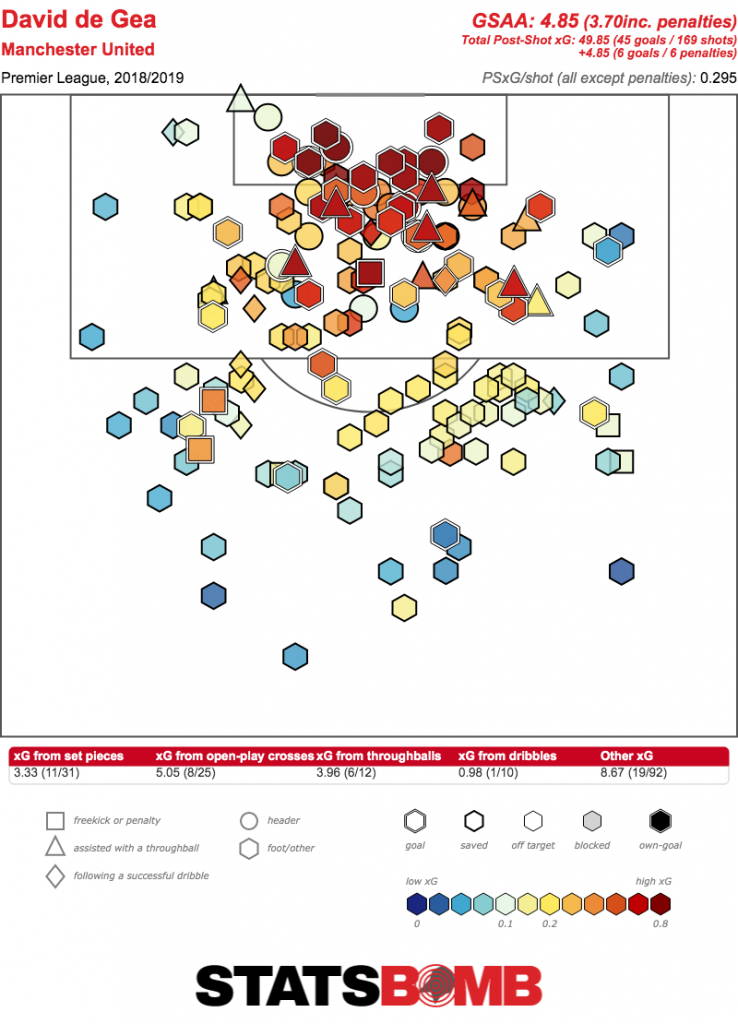 The post-shot xG model would expect the Spaniard to have conceded on average 9.28 non-penalty goals in the league since Solskjær arrived. He’s conceded slightly over half that many (plus the one penalty he faced). He is well and truly back in the form that earned him so many plaudits last season. You don’t even have to defend well when he’s in the zone like this. Can he maintain it? Everyone regresses to the mean at least somewhat over the long term. De Gea, though, is probably the best shot stopper on the planet, so one should likely expect at least a degree of overperformance going forward. On the attacking side, United have scored 19 non-penalty goals from an expected haul of 14.78 (as well as scoring all 4 of the penalties they have won). This isn’t a huge difference, so alarm bells shouldn’t be sounding, but with no obvious explanation in the way De Gea can describe things on the defensive end, the expectation should probably be that United will conform to their attacking numbers going forward. The biggest stick with which Solskjær has been beaten is the schedule he’s faced so far. The 9 league opponents since his arrival have an average position in the table of 14th. United won their lone legitimately tough league game so far, away to Tottenham 1-0, but the numbers suggest that wasn’t the strongest performance.
The post-shot xG model would expect the Spaniard to have conceded on average 9.28 non-penalty goals in the league since Solskjær arrived. He’s conceded slightly over half that many (plus the one penalty he faced). He is well and truly back in the form that earned him so many plaudits last season. You don’t even have to defend well when he’s in the zone like this. Can he maintain it? Everyone regresses to the mean at least somewhat over the long term. De Gea, though, is probably the best shot stopper on the planet, so one should likely expect at least a degree of overperformance going forward. On the attacking side, United have scored 19 non-penalty goals from an expected haul of 14.78 (as well as scoring all 4 of the penalties they have won). This isn’t a huge difference, so alarm bells shouldn’t be sounding, but with no obvious explanation in the way De Gea can describe things on the defensive end, the expectation should probably be that United will conform to their attacking numbers going forward. The biggest stick with which Solskjær has been beaten is the schedule he’s faced so far. The 9 league opponents since his arrival have an average position in the table of 14th. United won their lone legitimately tough league game so far, away to Tottenham 1-0, but the numbers suggest that wasn’t the strongest performance. 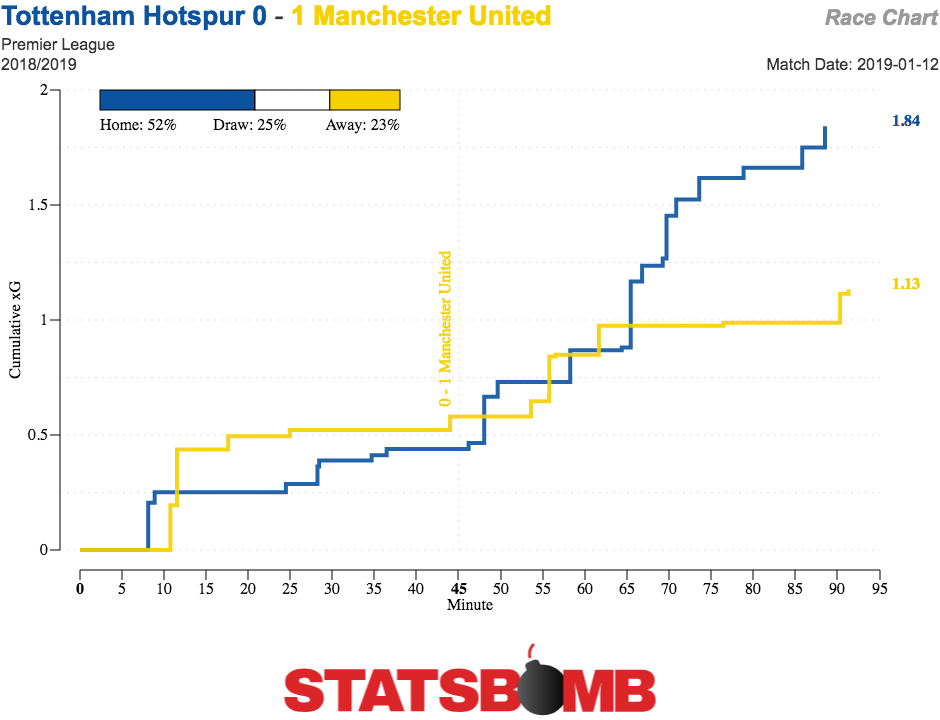 After going ahead just before the break, United were totally unable to soak up Spurs’ pressure in the second half, conceding chance after chance and relying on De Gea to pull off a series of spectacular saves. They got the three points, yes, but to claim it as any kind of successful performance requires strong outcome bias. The story was worse at home to PSG.
After going ahead just before the break, United were totally unable to soak up Spurs’ pressure in the second half, conceding chance after chance and relying on De Gea to pull off a series of spectacular saves. They got the three points, yes, but to claim it as any kind of successful performance requires strong outcome bias. The story was worse at home to PSG. 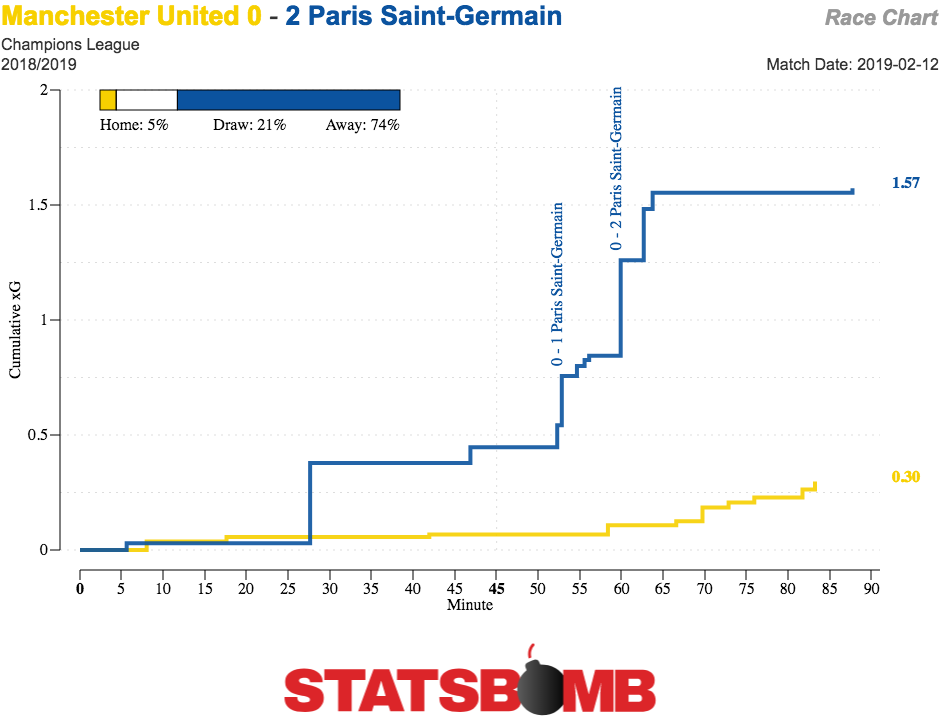 When you play a tactic largely of committing players forward against a team with Kylian Mbappé, you’re at risk of conceding. What might be more concerning is how little United offered going forward. Looking at their shot map, there was a huge empty space right in front of goal.
When you play a tactic largely of committing players forward against a team with Kylian Mbappé, you’re at risk of conceding. What might be more concerning is how little United offered going forward. Looking at their shot map, there was a huge empty space right in front of goal. 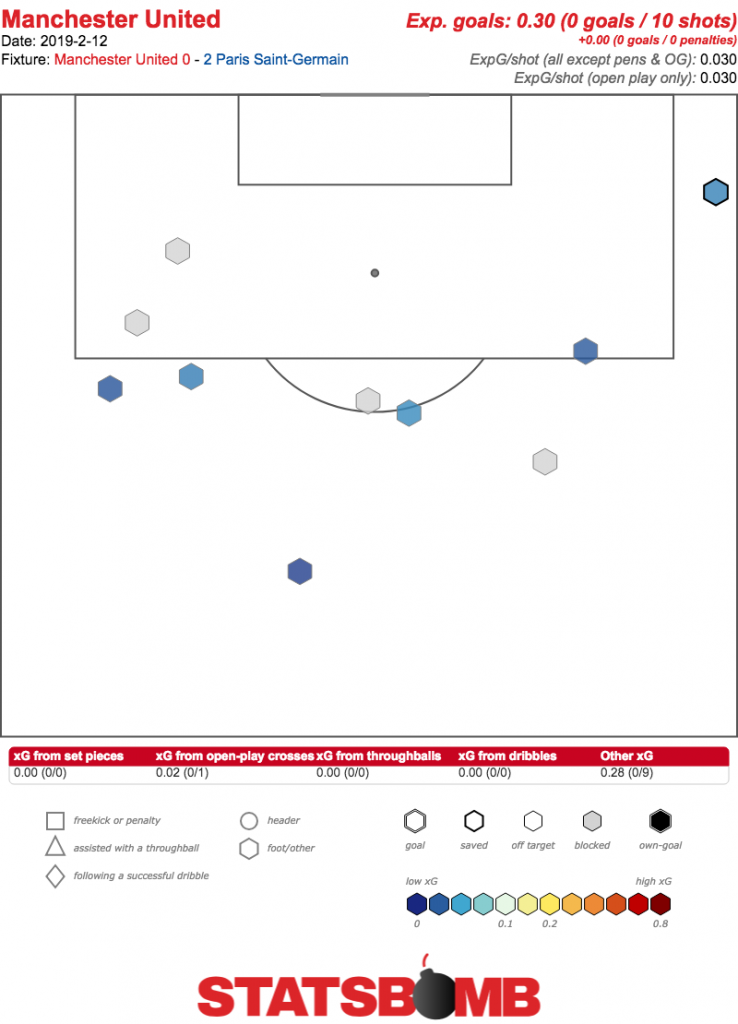 Why were United so bereft of attacking impetus? A certain Arsène Wenger had a theory. “What Paris Saint-Germain did”, Wenger claimed, “is they blocked Pogba with Marquinhos in man-to-man marking”. This was effective because Solskjær’s team “cannot build the game up, especially at the back. They cannot make good passes into midfield. Man United has a real lack of ideas to build the game”. In his time in charge, Solskjær’s attacking structure has been focused simply on giving the ball to Pogba, and letting him and the front three make penetrating runs. It is not obvious that he has a clear idea of how he wants his side to break down opponents. Things were admittedly brighter in the FA Cup win over Chelsea. Maurizio Sarri’s team attempted to play their usual possession-heavy approach and found themselves fairly easily exposed by United’s counter-attacking threat, with Chelsea having no clear plan for dealing with Pogba and allowing the Frenchman to dominate the game. There were concerns, though, particularly in the second half, with much of the game being played in United’s own half as Solskjær’s side looked unable to kill off the game. It was most likely a deserved win, though not an emphatic one, with the result arguably speaking more to Chelsea’s weaknesses than United’s strengths. All of this is fine if Solskjær is merely the interim manager. United were bad at the end of Mourinho’s reign. The players were unhappy. Everything at Old Trafford felt negative. Solskjær has come in and transformed the atmosphere, playing enjoyable if straightforward football and getting good results, even if there has been an element of good fortune about it. In terms of the road ahead, though, United may require a manager with more complex methods than what we’ve seen in recent months. Perhaps Solskjær has shades to him that we have not yet seen. If he is to become the permanent manager, he will need to have them. Header image courtesy of the Press Association
Why were United so bereft of attacking impetus? A certain Arsène Wenger had a theory. “What Paris Saint-Germain did”, Wenger claimed, “is they blocked Pogba with Marquinhos in man-to-man marking”. This was effective because Solskjær’s team “cannot build the game up, especially at the back. They cannot make good passes into midfield. Man United has a real lack of ideas to build the game”. In his time in charge, Solskjær’s attacking structure has been focused simply on giving the ball to Pogba, and letting him and the front three make penetrating runs. It is not obvious that he has a clear idea of how he wants his side to break down opponents. Things were admittedly brighter in the FA Cup win over Chelsea. Maurizio Sarri’s team attempted to play their usual possession-heavy approach and found themselves fairly easily exposed by United’s counter-attacking threat, with Chelsea having no clear plan for dealing with Pogba and allowing the Frenchman to dominate the game. There were concerns, though, particularly in the second half, with much of the game being played in United’s own half as Solskjær’s side looked unable to kill off the game. It was most likely a deserved win, though not an emphatic one, with the result arguably speaking more to Chelsea’s weaknesses than United’s strengths. All of this is fine if Solskjær is merely the interim manager. United were bad at the end of Mourinho’s reign. The players were unhappy. Everything at Old Trafford felt negative. Solskjær has come in and transformed the atmosphere, playing enjoyable if straightforward football and getting good results, even if there has been an element of good fortune about it. In terms of the road ahead, though, United may require a manager with more complex methods than what we’ve seen in recent months. Perhaps Solskjær has shades to him that we have not yet seen. If he is to become the permanent manager, he will need to have them. Header image courtesy of the Press Association
